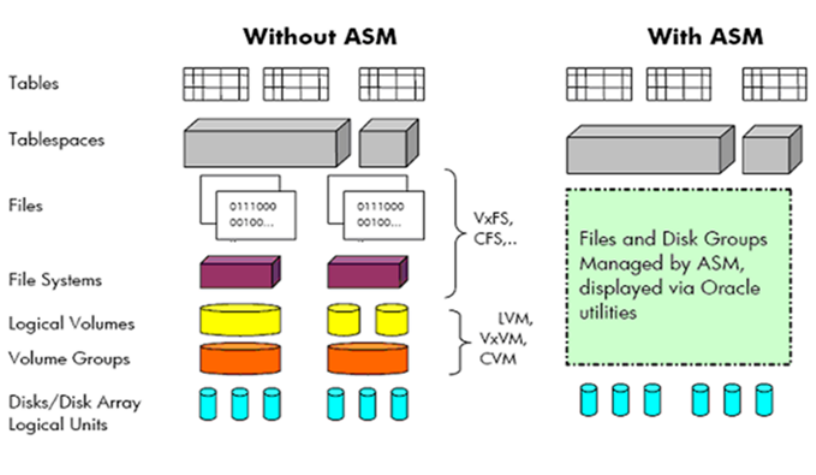HP Serviceguard Enterprise Cluster Master Toolkit User Guide (5900-2145, April 2013)
Table Of Contents
- HP Serviceguard Enterprise Cluster Master Toolkit User Guide
- Contents
- 1 Introduction
- 2 Using the Oracle Toolkit in an HP Serviceguard Cluster
- Overview
- Supported Versions
- Support for Oracle Database Without ASM
- Supporting Oracle ASM Instance and Oracle Database with ASM
- What is Automatic Storage Management (ASM)?
- Why ASM over LVM?
- Configuring LVM Volume Groups for ASM Disk Groups
- Sample command sequence for configuring LVM Volume Groups
- Serviceguard support for ASM on HP-UX 11i v3 onwards
- Framework for ASM support with Serviceguard
- Installing, Configuring, and Troubleshooting
- Setting up DB instance and ASM instance
- Setting up the Toolkit
- ASM Package Configuration Example
- Modifying a Legacy Database Package Using an Older Version of Oracle ECMT Scripts to use the Scripts Provided for ASM Support
- Adding the Package to the Cluster
- Node-specific Configuration
- Error Handling
- Network Configuration
- Database Maintenance
- Configuring and packaging Oracle single-instance database to co-exist with SGeRAC packages
- Configuring Oracle single-instance database that uses ASM in a Coexistence Environment
- Attributes newly added to ECMT Oracle toolkit
- Configuring a modular failover package for an Oracle database using ASM in a coexistence environment
- Configuring a legacy failover package for an Oracle database using ASM in a Coexistence Environment
- ECMT Oracle Toolkit Maintenance Mode
- Supporting EBS database Tier
- Oracle ASM Support for EBS DB Tier
- 3 Using the Sybase ASE Toolkit in a Serviceguard Cluster on HP-UX
- Overview
- Sybase Information
- Setting up the Application
- Setting up the Toolkit
- Sybase Package Configuration Example
- Creating the Serviceguard package using Modular method
- Adding the Package to the Cluster
- Node-specific Configuration
- Error-Handling
- Network configuration
- Database Maintenance
- Cluster Verification for Sybase ASE Toolkit
- 4 Using the DB2 Database Toolkit in a Serviceguard Cluster in HP-UX
- 5 Using MySQL Toolkit in a HP Serviceguard Cluster
- MySQL Package Configuration Overview
- Setting Up the Database Server Application
- Setting up MySQL with the Toolkit
- Package Configuration File and Control Script
- Creating Serviceguard Package Using Modular Method
- Applying the Configuration and Running the Package
- Database Maintenance
- Guidelines to Start Using MySQL Toolkit
- 6 Using an Apache Toolkit in a HP Serviceguard Cluster
- 7 Using Tomcat Toolkit in a HP Serviceguard Cluster
- Tomcat Package Configuration Overview
- Multiple Tomcat Instances Configuration
- Configuring the Tomcat Server with Serviceguard
- Setting up the Package
- Creating Serviceguard Package Using Modular Method
- Setting up the Toolkit
- Error Handling
- Tomcat Server Maintenance
- Configuring Apache Web Server with Tomcat in a Single Package
- 8 Using SAMBA Toolkit in a Serviceguard Cluster
- 9 Using HP Serviceguard Toolkit for EnterpriseDB PPAS in an HP Serviceguard Cluster
- 10 Support and Other resources
- 11 Acronyms and Abbreviations
- Index

Figure 1 Oracle database storage hierarchy without and with ASM
Why ASM over LVM?
As mentioned above, we require ASM disk group members in Serviceguard configurations to be
raw logical volumes managed by LVM. We leverage existing HP-UX capabilities to provide
multipathing for LVM logical volumes, using either the PV Links feature, or separate products such
as HP StorageWorks Secure Path that provide multipathing for specific types of disk arrays. Another
reason for using LVM is that, it is the responsibility of Serviceguard to provide the necessary I/O
fencing when it provides failover for a single-instance Oracle database instance. Serviceguard
ensures I/O fencing for a failover package via a feature in the volume manager - exclusive activation
of volume groups. Other advantages of the "ASM-over-LVM" configuration are as follows:
• ASM-over-LVM ensures that the HP-UX devices used for disk group members will have the
same names (the names of logical volumes in LVM volume groups) on all nodes, easing ASM
configuration.
• ASM-over-LVM protects ASM data against inadvertent overwrites from nodes inside/outside
the cluster. If the ASM disk group members are raw disks, there is no protection currently
preventing these disks from being incorporated into LVM or VxVM volume/disk groups.
The disadvantages of the ASM-over-LVM configuration are as follows:
• Additional configuration and management tasks are imposed by the extra layer of volume
management (administration of volume groups, logical volumes, physical volumes).
• There is a small performance impact from the extra layer of volume management.
Configuring LVM Volume Groups for ASM Disk Groups
We require ASM disk group members in Serviceguard configurations to be raw logical volumes
managed by LVM. But these logical volumes presented to ASM should resemble raw disks, as
much as possible. Hence, each LVM logical volume (LV) used as a member of an ASM disk group
is required to be laid out to occupy the usable space, in contiguous fashion, of exactly one single
physical volume (PV). This implies that the LV:
• should be contiguous.
• should not be striped or mirrored.
32 Using the Oracle Toolkit in an HP Serviceguard Cluster










